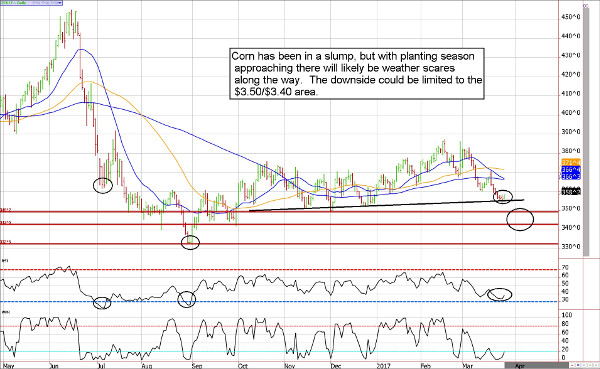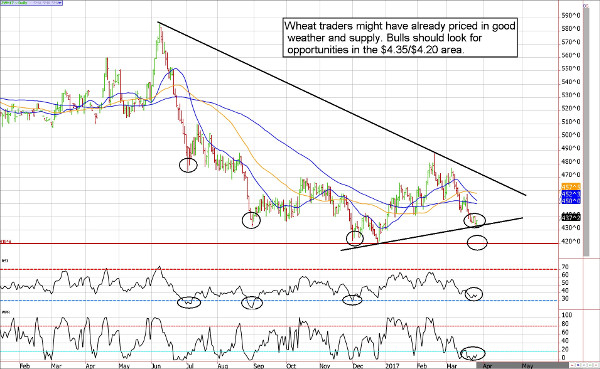Grain futures appear to be on the cheap side which should provide attractive risk to reward prospects for the bulls, according to Carley Garner, an experienced commodity broker with DeCarley Trading, LLC (DeCarleyTrading.com)
The grain complex traded on the CBOT (Chicago Board of Trade) division of the CME Group (Chicago Mercantile Exchange), have been in a slump but there are reasons to believe the tides may be turning in the coming weeks.
Those wishing to play the upside in the grains might consider doing so from support levels (subsequently noted) ahead of the summer growing season for soybeans and corn, and the wheat harvest season. Although the growing cycles for corn and soybeans are opposite that of wheat in that farmers are planting corn as wheat is being harvested and vice versa, all three often move together when there is a weather scare. After all, they are all substitutes for one another in many circumstances.
In regards to renewable commodities, such as the grains, prices are capable of massive fluctuation from year to year. Further, market fundamentals can change in what seems like the blink of an eye. Take, for example, an unexpected heat wave threatening the germination or low pollination of planted seeds; these types of unpredictable weather events can challenge the yields of any particular crop. In other words, just because the grain is in the ground in the spring doesn’t mean it will translate into a marketable product in the fall. It is this uncertainty that speculators live and sometimes die for.
We cannot ignore the fact that corn and soybeans tend to struggle during March and April as prices relax following the pricing in of weather risk premium earlier in the year, but it feels like most of that repricing has already occurred. Given the fact that grains are trolling recent lows, which happen to also be multi-year lows, leaves us feeling like the downside is limited but the upside has some real potential.
May corn futures have found a moderate amount of support in the mid-$3.50 area that might be worth nibbling on by aggressive traders. Conservative players might be better served to wait for a dip into the $3.50 to $3.40 area before initiating a position. Corn did briefly touch $3.30 in the fall 2016, but aside from that temporary blip, we haven’t seen corn trade under $3.50 for any significant amount of time. Thus, in addition to potential weather scares the corn market has technical support in its favor.
The July wheat futures traded on the CBOT are also on the skids, but some are wondering whether there is anybody left to sell. The Commodity Futures Trading Commission (CFTC) issues a weekly report detailing how long or short speculators are in each particular commodity.
In wheat, large speculators (assumed to be the smart money) are holding a rather large short position. While it is possible this group gets moderately more bearish, it is more likely they become interested in taking profits off the table. If so, they will be buying futures back to unwind their shorts which will put upward pressure on prices. Accordingly, be on the lookout for a potential trend reversal somewhere between $4.35 to $4.20.
Grain futures appear to be on the cheap side which should provide attractive risk to reward prospects for the bulls. In addition to technical and weather support in the corn and wheat markets, the lower US dollar should also provide a spark. After all, as the dollar weakens it makes US exports of commodities look cheaper to overseas buyers. Thus, we like the idea of preparing for bullish trades in this complex.
Carley Garner is the Senior Strategist for DeCarley Trading, a division of Zaner, where she also works as a broker. She authors widely distributed e-newsletters; for your free subscription visit www.DeCarleyTrading.com. She has written four books, the latest is titled “Higher Probability Commodity Trading” (July 2016).























